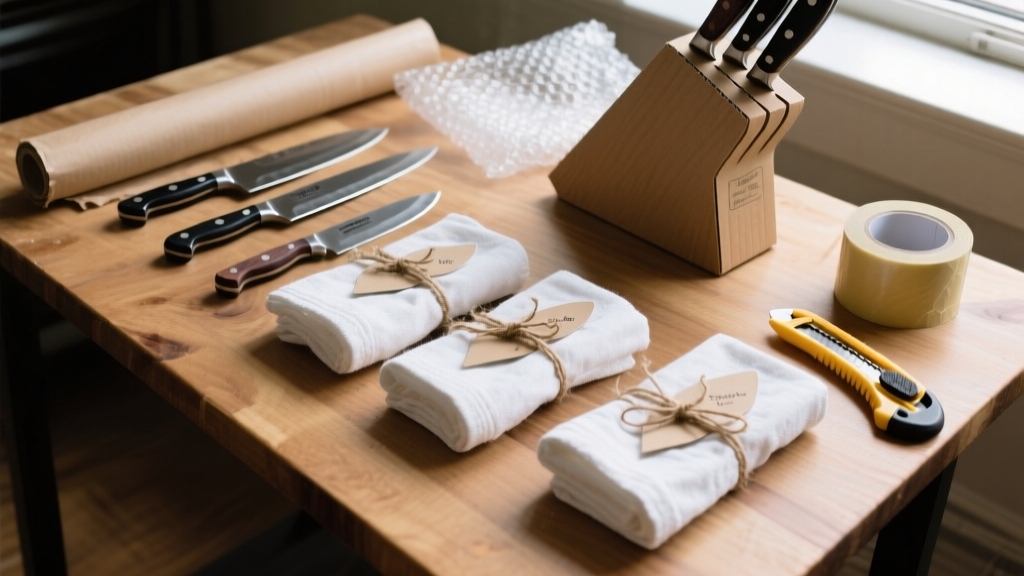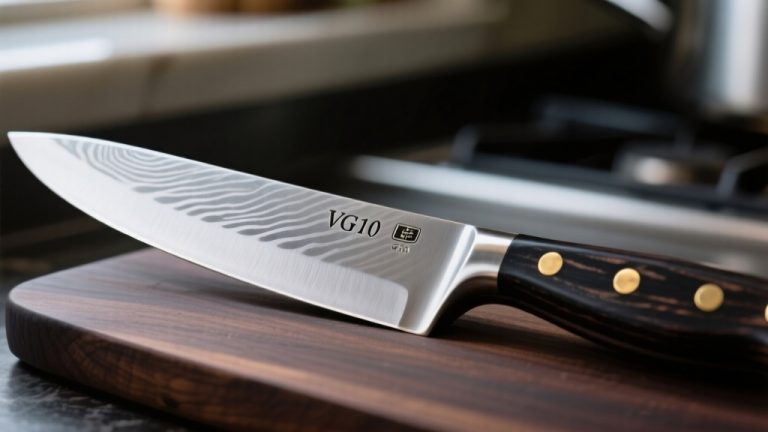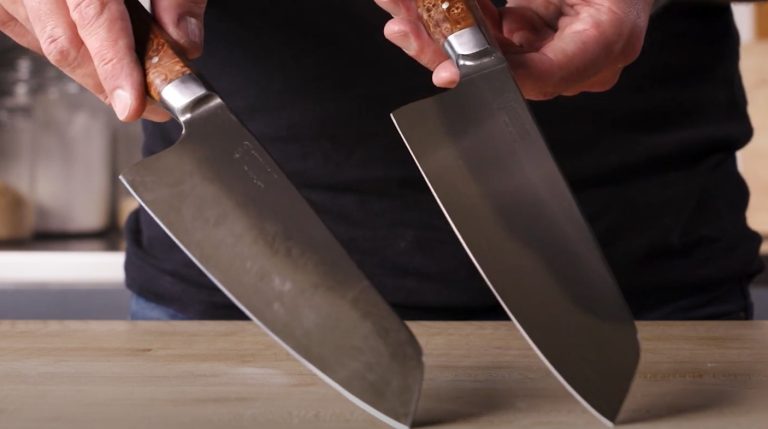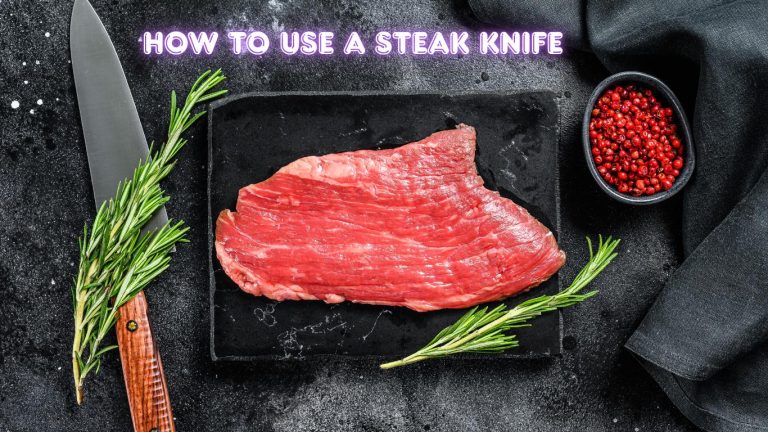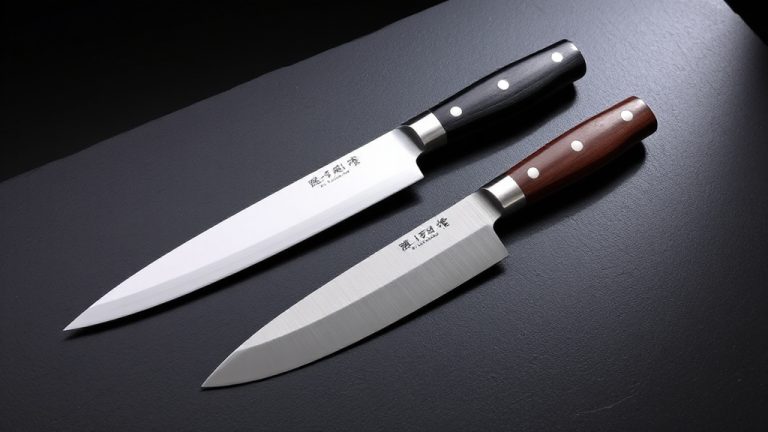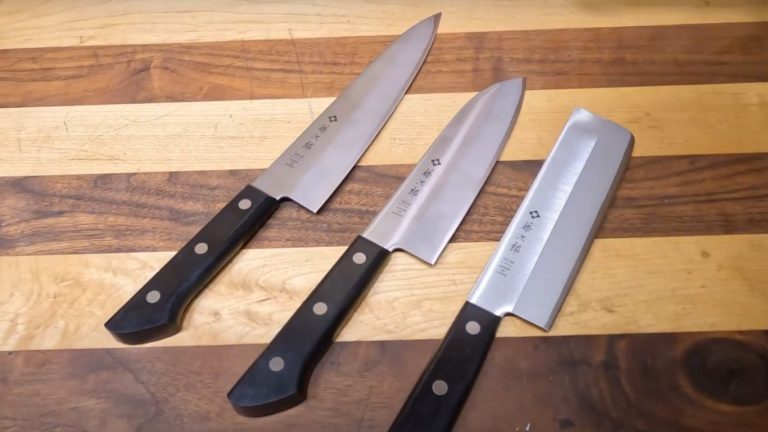How to Pack Knives for Moving Safely and Efficiently?
To pack knives safely for moving, first wrap each blade securely in tear-resistant packing paper or bubble wrap, covering the edge and tip completely.
Bundle knives in small groups, alternating blade directions to avoid dulling edges. Use knife guards if available, then place bundles in a sturdy box with cushioning material to prevent shifting.
Seal and label the box clearly with sharp object warnings. Following these steps guarantees safety and protection; you can also explore tips on unpacking and storage.
Key Takeaways
- Wrap each knife blade fully with tear-resistant materials and secure tightly with packing tape to prevent injury and damage.
- Bundle knives in groups of 4–5, alternating blade directions and securing with packing paper or knife rolls for safe transport.
- Use plastic or rubber blade guards for extra protection before placing knives in cushioned double-wall corrugated boxes.
- Fill empty spaces in boxes with foam sheets or packing peanuts to stabilize knives and prevent shifting during transit.
- Label boxes clearly with “Sharp” warnings and handle orientation arrows, and inform movers about the knife contents.
Preparing and Wrapping Knife Blades
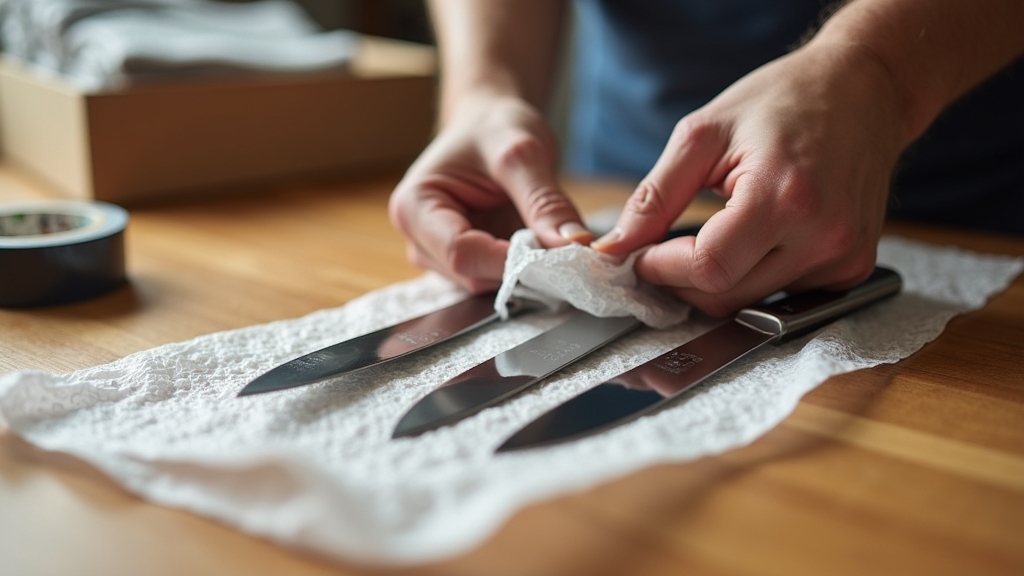
When preparing and wrapping knife blades for moving, you’ll want to choose sturdy, tear-resistant materials like bubble wrap or packing paper to fully cover each blade. Select wraps thick enough to extend several inches beyond the blade tip, ensuring complete protection.
Lay the knife diagonally on the material and roll it snugly, folding edges over to create a secure pocket around the blade. Use durable packing tape to seal the wrap tightly, focusing on ends and seams to prevent unwrapping.
For added safety, consider plastic or rubber knife guards that fit each blade’s size, providing a hard barrier against damage or injury. Ensuring the knives are completely dry before packing helps prevent rust formation during transit.
Clearly marking boxes as sharp objects is essential to ensure safety during handling and transit. Avoid thin, weak materials that risk tearing, exposing blades, or damaging boxes during transit.
Organizing and Bundling Knives for Packing
Although organizing knives by type and size might seem tedious, it’s essential for safe, efficient packing. Start by grouping knives, such as bread, steak, and chef, and separating large blades from smaller ones to prevent damage and ease handling.
It is also important to clean and dry all knives beforehand to prevent rust or damage, especially carbon steel varieties, ensuring longevity during your move. Proper maintenance of knives, including regular sharpening, helps maintain their edge and performance after unpacking.
Keep similar blade sizes together for compact bundling. When bundling, alternate blades in opposite directions to minimize edge contact. Roll knives in 3–4 sheets of packing paper and secure bundles with tape. Limit each bundle to 4–5 knives, depending on size.
Use knife rolls, blade guards, or DIY cardboard guards for added protection and easier transport. After bundling, add a layer of bubble wrap and place bundles flat in cushioned boxes. Fill gaps to prevent shifting.
Label boxes clearly as “Sharp Object Warnings” to ensure careful handling throughout your move. This precaution helps prevent accidents and protects the knives’ edges from dulling due to contact with hard surfaces like granite countertops.
Choosing and Using Packing Materials at Home
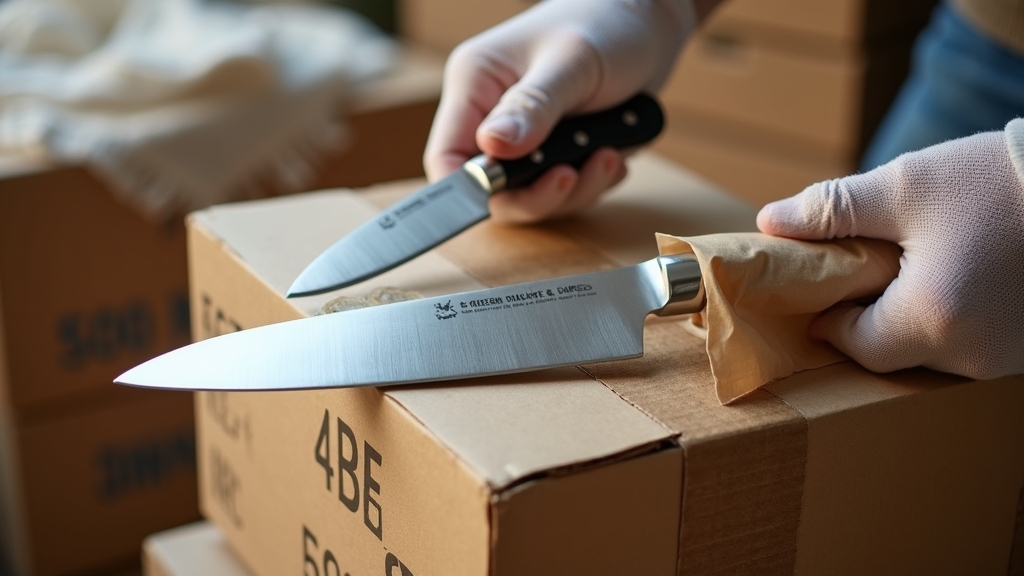
To pack knives safely at home, you need the right materials that offer protection and stability. Choose small to medium sturdy cardboard boxes, preferably double-wall corrugated, to support the knives’ weight and shape. Using boxes with durable construction helps prevent damage during transit.
Avoid damaged or oversized boxes to prevent shifting and damage. Wrap each knife individually with packing paper, securing with plastic wrap if needed. Use small-bubble bubble wrap for delicate blades and fill gaps with foam sheets or packing peanuts to keep knives stable.
Seal boxes with strong, reliable packing tape, reinforcing corners and edges to maintain integrity. Keep scissors and utility knives handy for precise cutting. Using packing tape helps label boxes clearly, which is essential for organization during moving.
Safety Tips for Packing and Labeling Knife Boxes
Because knives pose unique risks during a move, you must prioritize safety by using proper packing and labeling techniques. Always cover blades with knife guards or wrap them individually in bubble wrap or packing paper, focusing on blade tips.
Bundle knives by size, securing with rubber bands, and align blades facing the same direction to prevent shifting. Use sturdy, reinforced boxes, seal them tightly, and never overpack.
Clearly label each box with “Sharp” warnings and handle orientation arrows using permanent markers on multiple sides for visibility. Keep knife boxes separate from heavy items and store them securely in the vehicle.
Clean and dry knives before packing to avoid damage. Inform movers about the contents to reduce accidents. These steps ensure safety and protect both your knives and handlers during the move. Additionally, applying a food-grade mineral oil finish before packing can help protect wooden knife handles from drying and cracking during transit.
Best Practices for Unpacking and Storing Knives
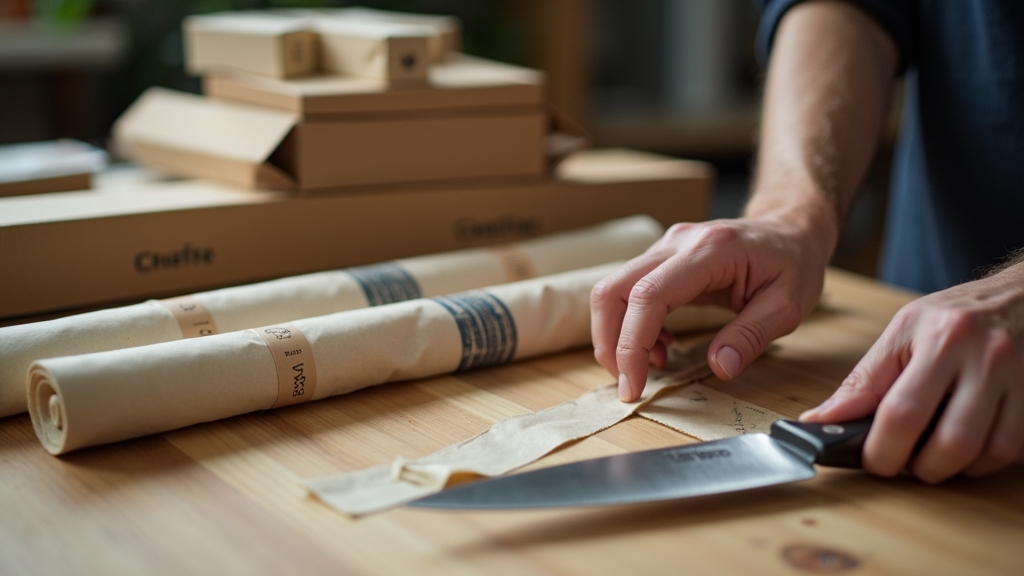
When unpacking your knives, prioritize careful handling to prevent damage and injury. Unpack them one at a time, ensuring blades stay protected to avoid accidental cuts and maintain blade integrity.
Choose storage solutions that fit your needs, whether for display, security, or easy access. Consider these best practices:
Use knife rolls for organized, durable storage but expect some blade movement. Magazine pouches can also be useful for storing knives, as their vertical pockets are typically wide enough for most EDC items.
Opt for wooden display cases to showcase and protect your collection elegantly. Proper maintenance and cleaning are essential to preserve the sharpness and longevity of your knives.
Repurpose foam-lined gun cases for secure, compact storage with cushioned protection.
Retain original packaging in labeled bins for long-term, space-considerate storage.
Install custom drawer organizers to prevent blade contact and maximize kitchen safety. Regular cleaning and oiling of blades can prevent rust and ensure smooth operation.
Frequently Asked Questions
Can I Pack Knives With Other Kitchen Utensils Safely?
Yes, you can pack knives safely with other kitchen utensils if you take precautions. Always cover each blade with a protective guard, sheath, or thick towel to prevent cuts and damage.
Bundle knives separately from flatware using rubber bands and paper to avoid shifting. Use sturdy boxes with compartments or knife rolls, and clearly label the box as containing sharp items.
This keeps you and your movers safe while protecting your knives and utensils.
How Do I Dispose of Old or Damaged Knife Packaging?
Think of old knife packaging as a puzzle with sharp edges. Don’t just toss it carelessly. Break down the packaging into smaller pieces, ensuring any plastic or foam is clean and dry.
Recycle cardboard or paper parts following your local guidelines. For plastic components, check if they’re recyclable. If not, dispose of them in regular trash.
Always avoid mixing sharp materials with recyclables to keep waste handlers safe.
Are There Specific Knife Brands That Need Special Packing Care?
Yes, brands like Wüsthof, Shun, Global, and Kyocera need special care. Their high-quality steel and delicate finishes require extra padding and acid-free paper to prevent corrosion and scratches.
Ceramic blades, especially from Kyocera, are brittle and need multiple soft layers. Wooden handles demand moisture protection.
Use dedicated knife rolls or custom foam inserts, and always secure blades with guards. Following these steps preserves your premium knives during transport.
What Should I Do if a Knife Gets Damaged During the Move?
If a knife gets damaged during your move, don’t use it to avoid injury. Inspect for cracks, chips, or loose handles.
Document the damage with photos and notify your moving company immediately to file a claim. Store the knife separately, wrapped securely.
For minor blade chips, consider professional sharpening. For severe damage, replace the knife.
Dispose of irreparable knives safely, wrapping and labeling them clearly to prevent accidents.
Can Professional Movers Pack Knives for Me?
Yes, professional movers can pack knives for you. About 75% of full-service movers include this in their fragile item packing.
They use specialized materials like knife guards and padded wraps to keep blades safe and secure. Hiring them reduces your injury risk and protects your knives from damage.
Just confirm their policy ahead, as some may charge extra or require you to supply packing materials for sharp objects.
Master the Art of Packing Knives for a Smooth Move
By carefully wrapping each blade like a treasure, you protect your knives from nicks and damage during the move.
Bundling them securely and choosing sturdy packing materials creates a fortress against shifting boxes.
Label each box clearly, so unpacking feels like unwrapping a gift, not a gamble.
With these practical steps, your knives arrive sharp and ready, turning the chaos of moving into a smooth, confident progression.

